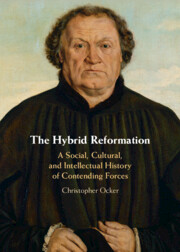Book contents
- The Hybrid Reformation
- The Hybrid Reformation
- Copyright page
- Additional material
- Dedication
- Contents
- Preface
- Part I Indifference and Ambiguity
- Part II Medieval Protestants
- Part III Interpretation beyond Borders
- 7 Erasmus and Biblical Scholasticism
- 8 A Literal Incident, a Spiritual Menace
- 9 The Trouble with Allegory
- 10 Third Forces in a Hybrid Reformation
- Bibliography
- Index
9 - The Trouble with Allegory
from Part III - Interpretation beyond Borders
Published online by Cambridge University Press: 30 September 2022
- The Hybrid Reformation
- The Hybrid Reformation
- Copyright page
- Additional material
- Dedication
- Contents
- Preface
- Part I Indifference and Ambiguity
- Part II Medieval Protestants
- Part III Interpretation beyond Borders
- 7 Erasmus and Biblical Scholasticism
- 8 A Literal Incident, a Spiritual Menace
- 9 The Trouble with Allegory
- 10 Third Forces in a Hybrid Reformation
- Bibliography
- Index
Summary
Allegory is an undeniably central feature of Renaissance literature. But it is often reduced to a Catholic or an anti-Catholic cliché. Too often, the entanglement of Catholic and Protestant interpretation and the survival of theological interests in biblical study are quickly downplayed. To document the continued importance of figurative reading in early-modern bible scholarship, this chapter views allegory broadly, as a manner of figurative reading evident in the way theologians practiced interpretation. It draws widely from a great variety of materials, roaming across the vast landscape of post-Reformation bible scholarship to suggest that the trouble with allegory was this: not that allegory exists, but that it must exist, it could never be overcome, and its division from the literal always remained fluid and tenuous. Biblical allegory becomes an expression of yet another “third force” in early modern religion, because the bible evaded a simple assertion of literalism and because it eluded confessional boundaries among the very people who helped create and police them.
Keywords
- Type
- Chapter
- Information
- The Hybrid ReformationA Social, Cultural, and Intellectual History of Contending Forces, pp. 201 - 243Publisher: Cambridge University PressPrint publication year: 2022

